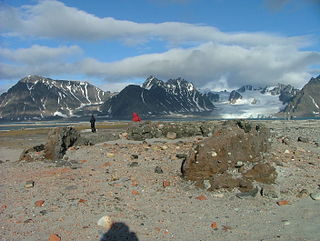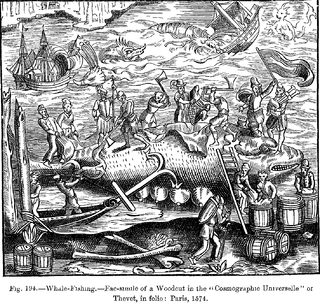Related Research Articles

The 16th century in Canada saw the first contacts, since the Norsemen 500 years earlier, between the indigenous peoples in Canada living near the Atlantic coast and European fishermen, whalers, traders, and explorers.

Smeerenburg was a whaling settlement on Amsterdam Island in northwest Svalbard. It was founded by the Danish and Dutch in 1619 as one of Europe's northernmost outposts. With the local bowhead whale population soon decimated and whaling developed into a pelagic industry, Smeerenburg was abandoned around 1660.

This article discusses the history of whaling from prehistoric times up to the commencement of the International Whaling Commission (IWC) moratorium on commercial whaling in 1986. Whaling has been an important subsistence and economic activity in multiple regions throughout human history. Commercial whaling dramatically reduced in importance during the 19th century due to the development of alternatives to whale oil for lighting, and the collapse in whale populations. Nevertheless, some nations continue to hunt whales even today.

A whaler or whaling ship is a specialized vessel, designed or adapted for whaling: the catching or processing of whales.
Jean-François Hodoul was a sea captain, corsair, and later merchant and plantation owner in Isle de France (Mauritius).
Nicholas Woodcock was a 17th-century English mariner who sailed to Spitsbergen, Virginia, and Asia. He piloted the first Spanish whaling ship to Spitsbergen in 1612 and participated in the Anglo-Persian sieges of Kishm and Ormus in 1622.

Fairhaven is an area of Norway. Generally speaking, it is the area between Amsterdam Island and Danes Island and the mainland, while specifically it refers to the sound between Danes Island and the mainland, in particular the strait between Moseøya and Danes Island. The modern name for this area is Smeerenburgfjorden.

Bellsund is a 20-kilometer (12 mi) long sound on the west coast of Spitsbergen, part of the Svalbard archipelago of Norway. It is separated from Van Mijenfjorden by the islands of Akseløya and Mariaholmen. Bellsund is located south of Nordenskiöld Land and north of Wedel Jarlsberg Land.
Thomas Edge was an English merchant, whaler, and sealer who worked for the Muscovy Company in the first quarter of the 17th century. The son of Ellis Edge, Thomas Edge was born in the parish of Blackburn in Lancashire in 1587/88. Edgeøya takes its name from him. Edge's Point, the eastern point of Recherche Fjord, also commemorated his name, but is now known as Lægerneset.
Kobbefjorden is a small fjord on the west coast of Danes Island, on the northwestern coast of Spitsbergen, the largest island of the Svalbard archipelago. The fjord is about two miles (3.5 km) long and 1-1.2 miles (1.5–2 km) wide. It offers one of the best anchorages on Spitsbergen's northwest coast, "being sheltered from most winds and ice-free for much of the year." At the head of the fjord is a valley, Kobbefjorddalen, which leads to the east coast of Danes Island. Kobbefjorden's southwesternmost point is Luftskipodden. Sir Martin Conway, on his visit to Spitsbergen in 1896–97, described the fjord as having "ice-smoothed hills of [the] hardest rock."

Hamburgbukta is a one-kilometer-long bay on the western side of Hoelhalvøya, Albert I Land, Spitsbergen in the Svalbard archipelago.

Willem Cornelisz. van Muyden was an early 17th-century skipper. He is known in the Netherlands as De Eerste Walvisvanger (1613). Van Muydenbukta and Van Mijenfjorden on the west coast of Spitsbergen and Kapp Muyen on the west coast of Jan Mayen are named after him.
Corfits Mogensen Ulfeldt was a Danish naval officer. He was a cousin of the much more famous traitor Corfitz Ulfeldt (1606–1664). He is known in the annals of whaling as the man who drove the French out of Spitsbergen. Ulfeldt later fought and died in the Torstenson War.

The Noordsche Compagnie was a Dutch cartel in the whaling trade, founded by several cities in the Netherlands in 1614 and operating until 1642. Soon after its founding, it became entangled in territorial conflicts with England, Denmark-Norway, France, and other groups within the Netherlands.
Virgohamna is a small bay on the northern coast of Danes Island, an island off the northwestern coast of Spitsbergen. Spitsbergen and Danes Island are islands of the Svalbard archipelago. The bay is named after SS Virgo, the vessel of Swedish engineer and explorer Salomon August Andrée's 1896 expedition. Virgohamna is located across a small strait from Smeerenburg, a historical whaling station on Amsterdam Island about 2 km to the north.

A patache is a type of sailing vessel with two masts, very light and shallow, a sort of cross between a brig and a schooner, which originally was a warship, being intended for surveillance and inspection of the coasts and ports. It was used as a tender to the fleet of vessels of more importance or size, and also for trans-Pacific travel, but later began to be used for trading voyages, carrying cargo burdens of 30 tons or more.
William Goodlad was a 17th-century English whaler. He was admiral of the Muscovy Company's London whaling fleet for nearly two decades, participating in several of the disputes involving the right to catch whales in Spitsbergen. The Arctic explorer Luke Foxe, in writing about the early voyages to Spitsbergen, said of him: "... but this I leave to Capt. Goodlade [sic], whose great experience this way, and to the E.-ward thereof, is the best able to supply or confute, if he be pleased so to shew himselfe".
The Basques were among the first people to catch whales commercially rather than purely for subsistence and dominated the trade for five centuries, spreading to the far corners of the North Atlantic and even reaching the South Atlantic. The French explorer Samuel de Champlain, when writing about Basque whaling in Terranova, described them as "the cleverest men at this fishing". By the early 17th century, other nations entered the trade in earnest, seeking the Basques as tutors, "for [they] were then the only people who understand whaling", lamented the English explorer Jonas Poole.
Ganges was a ship launched in 1798 at Philadelphia, probably for French owners. During the Peace of Amiens her registration and homeport became Dunkirk. Her French owners sent her to engage in whaling at Delagoa Bay, where the British letter of marque whaler Scorpion captured her in 1803. She then made one whaling voyage to Isle of Desolation before a French squadron captured her in 1806 during a second whaling voyage. Accounts differ as to whether her captors sank her, or released her and she continued to operate as a merchant vessel until 1814.

HMS Swallow was an 18-gun Albatross-class brig-sloop of the British Royal Navy, launched in 1795 and sold in 1802. During her naval career she captured a number of French privateers while on the Jamaica station. After her sale she became an armed whaler sailing under a letter of marque. As a privateer she captured two French whaling vessels but then is no longer listed after 1810.
References
- Conway, William Martin (1906). No Man's Land: A History of Spitsbergen from Its Discovery in 1596 to the Beginning of the Scientific Exploration of the Country. Cambridge, At the University Press.
- Dalgård, Sune (1962). Dansk-Norsk Hvalfangst 1615-1660: En Studie over Danmark-Norges Stilling i Europæisk Merkantil Expansion. G.E.C Gads Forlag.
- Henrat, P. 1984. French Naval Operations in Spitsbergen During Louis XIV’s Reign. Arctic 37: 544-551.
- Du Pasquier, Jean-Thierry (2000). Les baleiniers basques. Paris, SPM.